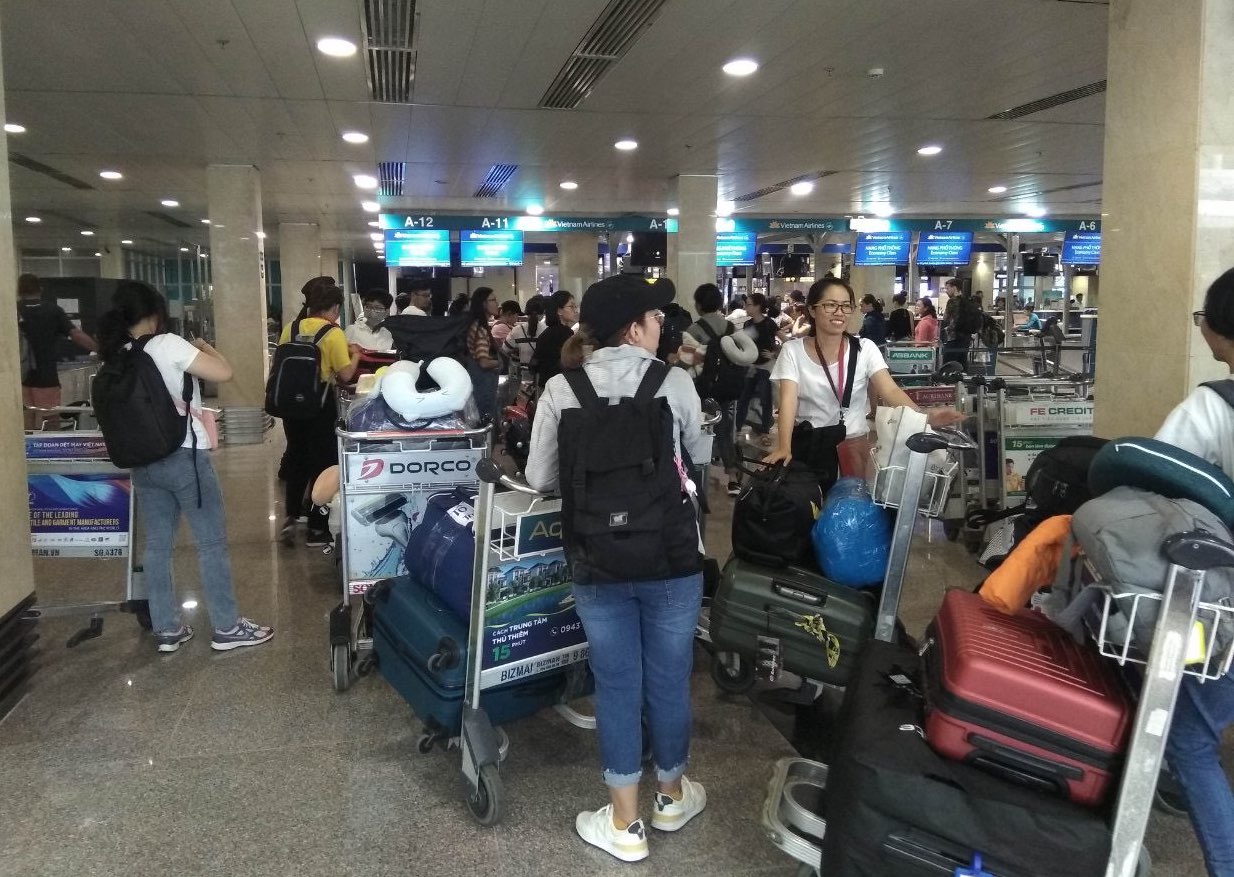From October 1st, 2019, Tan Son Nhat Airport will stop broadcasting at the terminal, except when changes in departure gates arise in an attempt to reduce noise pollution throughout the airport. Anticipating different possible situations, TOC has prepared appropriate solutions to ensure that passengers board their flights on time.
The conversation between VNA Spirit and Mr. Hoang Xuan Hiep – Head of Customer Service Department (TOC) will update the latest information about this change.
 Mr. Hoang Xuan Hiep – Head of Customer Service Department (TOC).
Mr. Hoang Xuan Hiep – Head of Customer Service Department (TOC).
Mr. Hiep, in just a few days, Vietnam Airlines will stop broadcasting flight information at the domestic terminal (T1). So how will the new notification methods at the airport be implemented?
Upon receiving the official documents about stopping the broadcasst at the international terminal from July 1st, 2019, and at the domestic terminal from October 1st, 2019, TOC has been proactively preparing passenger service plans. In particular, we’ve focused on providing information to passengers through screens and guidence signs at those terminals.
We have foreseen the potential impacts of stopping the broadcasts at check-in areas, personal document and baggage inspection areas, waiting rooms, passenger areas, and boarding areas. We also suggested that the airport arrange additional FIDS screens so that passengers can check information more conveniently. TOC also promptly cooperated with VIAGS/Security screening to develop additional programs to identify passengers with checked baggage that need to be re-checked with VeriPax security screening. This program has been tested with excellent results since being initialized in September 2019.
Communication is especially important, to make passengers aware and accustomized to this change. So from early September, we have been informing our customers through standees, notice sheets, and notification screens at the airport.
Since September 2019—to ensure that most passengers have been exposed to this notice as soon as possible—along with the standees at the check-in counters, security checks, on the way to the departure gates, and the business lounge, TOC has requested the airport provide ten additional standees at the departure gates, making the notice more visible.
At each traditional check-in counter, there are notice sheets and a check-in kiosk, so the staff will guide passengers to updating information while checking in. Currently, for check-in kiosks, TOC is following up with the service provider to display this notification screen during the check-in process. Everything is expected to be completed before October 1st, 2019. TOC has also requested the airport keep this notice on the billboards.
In the beginning, stopping the broadcasts will undoubtedly have some impact. So, what preperations has TOC made to ensure that passengers do not miss their flights?
Upon receiving notice of the plan to stop broadcasts in the Airport, TOC reviewed and identified possible risks then worked with VIAGS TSN to develop solutions. TOC has submitted a report identifying the risks at each passenger service position and appropriate measures to limit the effects for each of them.
In particular, we emphasize with our check-in officers to announce gate closure and departure time, update any change on the screens in the terminal, and to instruct passengers to make sure all luggage is checked through the security scanner before leaving the check-in area. In the security screening area, we will deploy more staff to filter and assist passengers in the terminals.
So specifically for passengers, what adjustments (if any) should they make?
Passengers need to change their habits from listening to broadcasts to proactively updating their flight information from screens and notice boards in the terminals. Passengers should also actively move to the departure gate at the scheduled time on their boarding pass and take note of any possible changes from the screens in the terminals. However, in the early stages of implementation, TOC will provide possible support within its capacity for passengers who unfortunately miss their flights due to this change.
 TOC has prepared options to assist passengers once the broadcasts are stopped at the T1 terminal. (Image: The Internet).
TOC has prepared options to assist passengers once the broadcasts are stopped at the T1 terminal. (Image: The Internet).
In your opinion, what is TOC’s biggest hurdle in implementing these plans?
TOC always wants VNA’s passengers to enjoy the best convenience and to be able to update all information during check-in at Tan Son Nhat airport. Therefore, our mission and also our obstcle is how to get big and clear FIDS screens loaded with all the information on flights at the check-in area and beyond security screening areas, at departure gates, and in the business lounge. The screens at the departure gates need to be bigger, displaying more information, especially about unusual flights, and also the instruction signs need to be clear and complete.
In addition to the proactive provision of screens and notice boards at the airport, the coordination between agencies in finding passengers when boarding time is closing, especially in peak season, can also be considered as a difficulty for TOC in the implementation phase.
What should TOC and other VNA units pay attention to and coordinate to do regarding the process of implementing the plan to assist passengers?
Most importantly, the offices, branches, and ticket agencies need to inform passengers at the moment of ticket purchase. At the airport, every staff needs to be proactive in providing information regarding changes, observing, and identifying passengers who need assistance, thus minimizing the potential risks of passengers missing their flights.
Although there will be some difficulties in assisting passengers at first, stopping the broadcasts at both domestic terminal (T1) and international terminal (T2) of Tan Son Nhat Airport to minimize noise and create a “quiet airport” follows a common trend in the world aviation industry. So what are TOC’s thoughts about this?
This is the general trend of the world aviation industry and the trend of civilization because nowadays, given the development of technology, information can reach passengers instantaneously.
However, in order to support passengers most effectively, similar to what major carriers have been doing, TOC wants VNA to develop a system to notify each passenger by text message to send information related to their flights step by step. Specifically, once passengers complete the check-in procedures, there will be a message confirming the seat number, departure time, boarding time, and expected departure gate. Ten minutes before the departure, there will be a message confirming the boarding time and departure gate. If the flight changes its departure gate, boarding time, or departure time, there will also be a message sent to passengers.
Through research, we found that at Aeroflot, when boarding or performing services, they always send information to passengers by text messages. This approach is considered to be a very effective system, helping passengers update information quickly and promptly.
Thank you for the interview!
Nguyen Mai Huong-COMM










